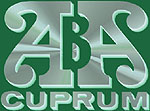
|
|
Mondo Artigiano di Magro Mara |
|
|
|
![]()
|
![]()
|
![]()
|
|

The Brama Ostra "Sharp Gate" (first known as "Miednicka" from the road connecting the town of Miednick through this gate then to Borysowa, Minsk, and Moscow) was built about 1514 when the defensive wall was constructed around Vilnius.
On this gate (as in on other gates, not just in Middle Ages Vilnius) there was the custom of hanging pictures of Christ, Mother of God, and Saints directly on the wall; (the Carmelites [Monks Order] hang them on the Sharp Gate).
These pictures (or paintings) were changed occasionally because of damage from the elements. Some of them were protected from the elements with little wooden doors and covers.
According to new research, the Mother of God of Ostra Brama was probably painted in Vilnius between 1620 and 1630 by an unknown artist. It was part of a folding diptych [two-part painting] showing Christ the Savior on the inside and the Mother of God on the outside; this diptych was copied from Krakow, Poland and other places. (The painting of Christ the Savior was started by Dutchman Martin DeVos in the Italian style; DeVos' painting was later taken off the diptych and kept first in the Sharp Gate Monastery, in Vilnius Cathedral later, and in the Art Museum in Vilnius after 1953).
The cult (ritualistic) worship of the Mother of God (in the Sharp Gate) of Ostra Brama began after the Muscovite attack of Vilnius in 1655; (the Carmelites [Monks] left Vilnius at that time). One of the strongest supporters of this cultic worship was the Carmelite preacher Father Francis Kielczewski ("Father Charles"). In 1627, he had built a wooden Chapel for the painting near Sharp Gate; it had an ascending staircase.
This Chapel was spared through several fires. However in 1711 (or 1715) the Chapel burned completely, but not before the miraculous painting was carried out of the fire by a young monk. For 20 years, the painting resided in the Church of St. Teresa. From 1712 to 1715 (or 1729) a new non-wooden Sharp Gate Chapel was built by the gate [after the old one burned down], and the miraculous painting was installed there with great ceremony.
In the year 1761, the Carmelite Father Rosciszewski published the famous book "The Story of The Miraculous Painting".
In 1764, a room behind the altar was added to the Chapel. And in 1789, there was the addition of a roofed worshipping area [open-air, with awning].
Pope Klemens XVI in 1773 assigned the Mother of God of Ostra Brama as the Patronage protector.
In 1794, there was a skirmish by Sharp Gate between the Russian Army and the [Polish] forces of the uprising defending Vilnius. There were the soldiers of Jasinski attempting to win independence from Russia. During these battles there was damage to the Chapel and to the painting. The damage was fixed in the same year, and in 1796 there was a thorough renovation of the Chapel.
The worship of the miraculous painting continued to grow, even among the Uniates [Greek/Byzantine Catholics]. When in 1799 the Tsarist forces began to destroy the walls and gates of Vilnius, Sharp Gate was left untouched (and even at this time new stairs to the chapel were built, perhaps according to the design of Rossi).
The invocation in Mickiewicz's Pan Tadeusz "To The Holy Virgin Shining in Sharp Gate" (this poetic novel was published in 1834) tremendously popularized the worship of the Mother of God of Sharp Gate beyond Vilnius and Litwa, Lithuania.
She (Mother of God of Ostra Brama) became the comforter of people with worries and a hope for the achievement of freedom during the time of partitions and national insurrections [in Lithuania].
(At this time a complete rebuilding of the Chapel occurred between the years 1829-1830. The staircase was completely redesigned in 1845, and there was the addition of a vestibule behind the altar in 1895).
During the time of the partitions, there were patriotic demonstrations inside the Sharp Gate Chapel as well as the street nearby. The demonstrations were particularly vocal during the "January Insurrection" (1853-1864) [against the repressive Tsarist control beginning in January 1863].
The worship of the Mother of God of Sharp Gate was at that time part of the Polish fight for independence directed against the Russian tyranny. (When the January Insurrection was put down in 1864, the inscription in the front of the Chapel, "Mother of Mercy we submit ourselves to your protection", was changed from Polish to Latin [to protect against any negative Russian reactions]).
On October 11, 1919, a procession of scientists, young people, government and [Catholic] Church dignitaries marched solemnly to Sharp Gate to thank the Mother of Mercy for the possibility of reopening Stefan Batory University in Vilnius.
In 1927, after the renovation of the painting (under the direction of John Rutkowski) and the Chapel (under the direction of Julius Klows), a formal ceremony was held in front of the Vilnius Cathedral in which crowns were added to Mother of God of Sharp Gate. The gold crowns, purchased with public donations, were affixed by the Papal Nuncio [Ambassador from the Pope] in the presence of Marshall Pilsudski, President Moscicki, and the faithful.
The chapel was renovated in 1931-1932 (J. Borowski). In 1933, following a campaign in the nationalistic press, the Polish inscription on Sharp Gate was reinstated (according to the design of Hoppen). In 1936, the Carmelites resumed caretaking of the Chapel. During WWII, the miraculous painting remained in Vilnius based on the decision of the Archbishop of Vilnius Romuald Jalbrzykowski [1876-1955] amongst the faithful who were now praying for freedom from the German and Soviet occupation. In Soviet [Communist] Vilnius, Sharp Gate remained open.

![]()
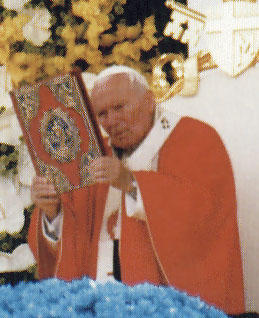
In Memoriam
Pope John Paul II
Pope John Paul II
visiting Lowicz, Poland
A copy of the Gospel Cover
is available
from ABA Cuprum
Mondo Artigiano di Magro Mara
![]()
![]()
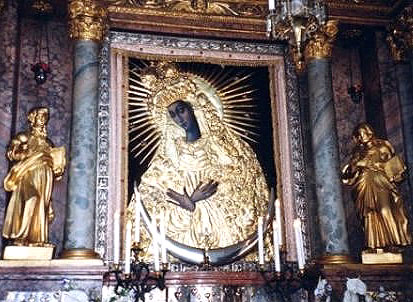
"Ostra Brama" Icon,
Vilnius (Wilno), Lithuania![]()
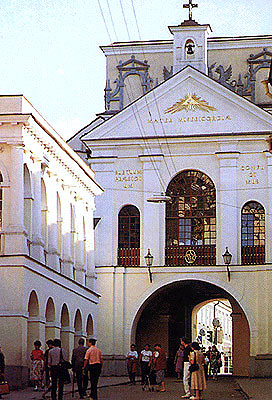
Ostra Brama Gate,
Viewed From One Side
Vilnius, Lithuania![]()
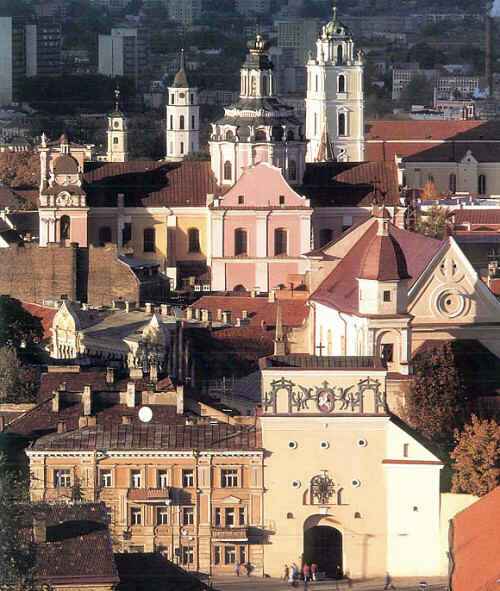
Ostra Brama Gate from Other Side
(Bottom, Right of Center, Yellow building)
Vilnius in Background![]()
Mother of God of Ostra Brama
by Maria Mary Kalamanska-Saeed,
PWN State Science Publishing House, Warsaw
1990 ISBN 83-01-10077-X
"[ ... ]" are additions by translator

![]()